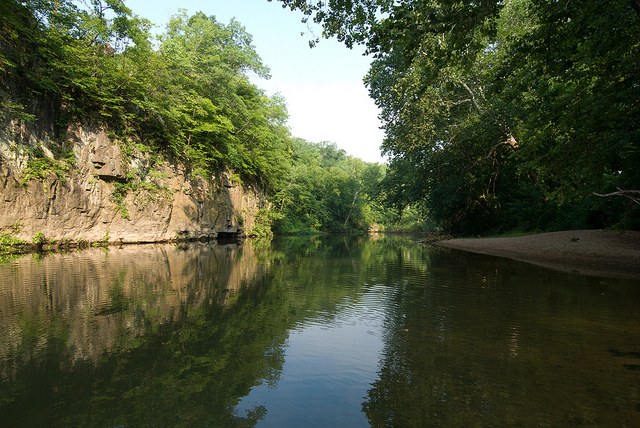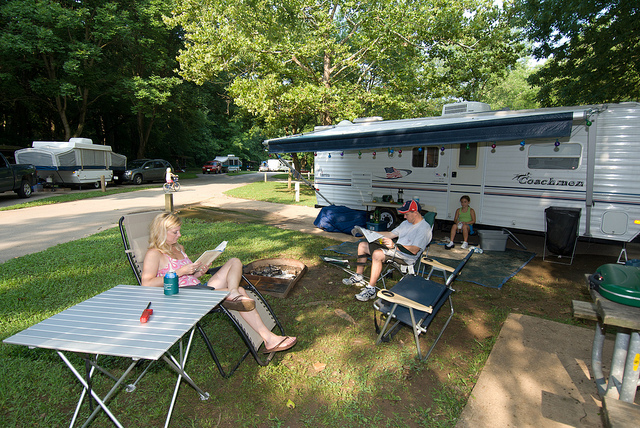at St. Francois State Park
Yesterday's Hideout, Today's Retreat
 The wild forested terrain of the Pike Run Hills once was refuge for desperate Civil War outlaws. Today, these same hills in St. Francois State Park serve as a natural refuge from modern-day life for thousands of visitors each year.
The wild forested terrain of the Pike Run Hills once was refuge for desperate Civil War outlaws. Today, these same hills in St. Francois State Park serve as a natural refuge from modern-day life for thousands of visitors each year.
The park is the result of an effort by the citizens of St. Francois County to preserve part of the area’s natural beauty. After a door-to-door fund drive, the first acreage for the park was purchased in 1964. With the aid of grants, matching funds and other donations, St. Francois State Park has grown to its present size.
The park’s history reflects the role it played in the area’s local cultural heritage. The first settlers in the area came to work the many lead mines around the park. Although the park land was explored for minerals and some surface mining was done, no significant deposits were ever found in the park.
When the Civil War came to Missouri, it divided many families. One such local family was the Hildebrands. Local residents still repeat stories about Sam Hildebrand, a guerrilla fighter who joined the Confederacy to avenge the death of his brother by the Union’s Missouri Militia. Hildebrand was known to hide out in a cave in the park.
Place names in the area give an idea of another part of the local cultural heritage. Many residents can still remember the moonshine stills that flourished in Mooner’s Hollow. Coonville Creek, which runs through Mooner’s Hollow, was a good source of cold, clear water – one of the most valuable ingredients for making good moonshine. According to local custom, it is called moonshine because "it seemed to work out better if concocted in the night under the light of an Ozark moon."
The park is rich in natural history as well as cultural history. The 2,256 acres that make up Coonville Creek Wild Area boast the forested ridges and hollows of the Pike Run Hills. Three trails provide access to this wild area covered with woodlands of white oak, black oak, shagbark hickory and dogwood. Coonville Creek and its narrow valley make up Coonville Creek Natural Area. Small springs, tributaries and wet meadows, or fens, feed this high-quality Ozark stream. Many rare northern plants continue to thrive in the moist, sheltered conditions of these fens. Several trails, one of which allows equestrians, wind through these wild areas and other scenic areas of the park. A park naturalist offers nature walks, slide shows, audio/video presentations and demonstrations, many of which are held in the park’s outdoor amphitheater, to inform visitors on a variety of nature topics.
 The Big River marks the southern boundary of the park. Scenic dolomite bluffs overlook the river, and grassy forest openings known as glades occur on several of the south-facing slopes. This slow-moving Ozark stream is ideal for families and novice canoeists. Anglers enjoy casting their lines into the river for bass, catfish and sunfish. Visitors can cool off by taking a dip in a swimming hole or just wading along the river’s edge.
The Big River marks the southern boundary of the park. Scenic dolomite bluffs overlook the river, and grassy forest openings known as glades occur on several of the south-facing slopes. This slow-moving Ozark stream is ideal for families and novice canoeists. Anglers enjoy casting their lines into the river for bass, catfish and sunfish. Visitors can cool off by taking a dip in a swimming hole or just wading along the river’s edge.
More than 160 picnic sites are scattered throughout the heavily wooded park, alongside the Big River and Coonville Creek, providing a place to relax and take a break from the day’s activities. Two picnic shelters can be reserved for family reunions or large gatherings. Playground equipment, horseshoe pits and open ball fields are located near the shelters to entertain young and old.
Overnight accommodations include basic and electric campsites. Modern restrooms, hot showers and a dumping station are located in the campground area.
The Pike Run Hills continue to be a refuge for rare plants, wild animals and people seeking solitude.






